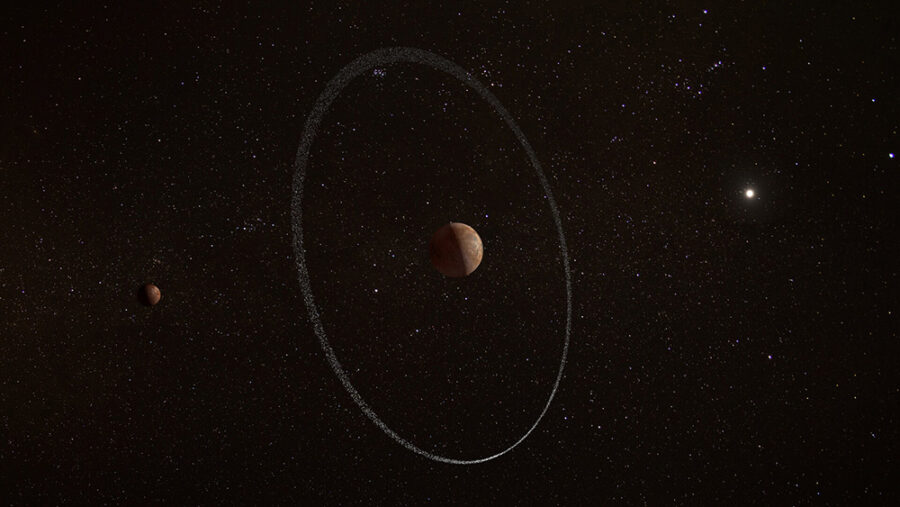There’s a second ring around the far-out dwarf planet Quaoar, adding to the mystery of how this world hosts rings at such wide orbits.

ESA / CC BY-SA 3.0 IGO
Earlier this year astronomers reported a ring orbiting unexpectedly far from the distant dwarf planet 50000 Quaoar. Now, they've gone back to check their puzzling find with bigger telescopes. The new observations verify the existence of the ring — and have turned up a second one closer to Quaoar. The new ring is still well outside the body's Roche limit, where theory says ring material should clump together rather than spread out.
Australian amateur astronomers Jonathan Bradshaw, Renato Langersek, and John Broughton discovered the first ring in 2021 by observing background stars blocked, or occulted, as Quaoar and material orbiting it passed in front of them. A group of 59 astronomers followed up, watching other background stars wink out during occultations. The group mapped the rings in Nature.
Now, in Astronomy and Astrophysics a group of 69 astronomers led by Chrystian Luciano Pereira (Brazil National Observatory) used two large telescopes on Mauna Kea, Hawai‘i, Gemini North and the Canada France-Hawaii Telescope, and a host of smaller ones to study an additional occultation that occurred in August 2022. “These are the best data sets we have up to now,” says team member Felipe Braga-Ribas (Federal University of Technology, Brazil).
The data confirm that the first ring, now called Q1R, orbits 4,060 kilometers (2,520 miles) from Quaoar. It also showed the ring has a dense and narrow middle that’s about 5 km across, surrounded by an envelope of more dispersed material that’s about 60 km wide. Its structure resembles that of the F ring around Saturn. The widest part of the ring yet observed is 300 km. Although individual occultations can only sample one or two slices of the ring at a time, the ring is probably complete.
The new observations also led to the discovery of an inner ring, called Q2R, which is about 10 km wide and orbits 2,520 km out. Like the outer ring, the second ring is outside the Roche limit. While only seen during a single occultation event, and thus not yet examined in much detail, the areas probed so far seem to be more constant in width and density. “This reveals how curious and complex Quaoar's system can be,” observes Luciano Pereira.
Generally speaking, rings exist only inside a world’s Roche limit, where the larger object’s gravity breaks up any would-be moons. Outside this limit, though, material ought to coagulate; in other words, a ring shouldn’t be stable so far out.
With now two rings to explain, the researchers investigated possible resonances within the Quaoar system. They found that the dwarf planet is in a 1:3 resonance with its outer ring: one orbit of the ring particles to three rotations of Quaoar. The period of the inner ring puts it close to a 5:7 resonance.
The rings surrounding two other small bodies, the asteroid 10199Chariklo and the Pluto-size 136108 Haumea, have a 1:3 resonance like Q1R; however, neither world’s ring is outside the Roche limit. It’s also possible small “shepherd” satellites might stabilize the rings, Luciano Pereira adds, but none have yet been discovered.
The findings “are very credible,” says Matthew Hedman (University of Idaho), who was not involved in either ring study. “This second ring implies that there is something very unusual about this system that we do not yet understand.” Most interestingly, he adds, the existence of the second ring “implies that whatever led to the formation of the rings far from Quaoar was not a one-off event.”
 2
2









Comments
Yaron Sheffer
May 17, 2023 at 12:58 pm
Er, I am an astronomer, but not very puzzled 🙂
To me, the Roche limit always signified the lowest orbit of a solid body, below which it would break into ring particles. I never thought of it as an upper limit for ring placement. Rings can form anywhere via collisions, and are indeed found beyond the Roche limit.
You must be logged in to post a comment.
Monica Young
May 30, 2023 at 10:19 am
While not covered in this article, the astronomers involved did consider collisions as a source of these rings and found that origin to be unlikely (see our coverage of the first ring discovery here: https://skyandtelescope.org/astronomy-news/astronomers-discover-unexpected-ring-around-distant-dwarf-planet/). Hence the puzzlement! 🙂
You must be logged in to post a comment.
You must be logged in to post a comment.